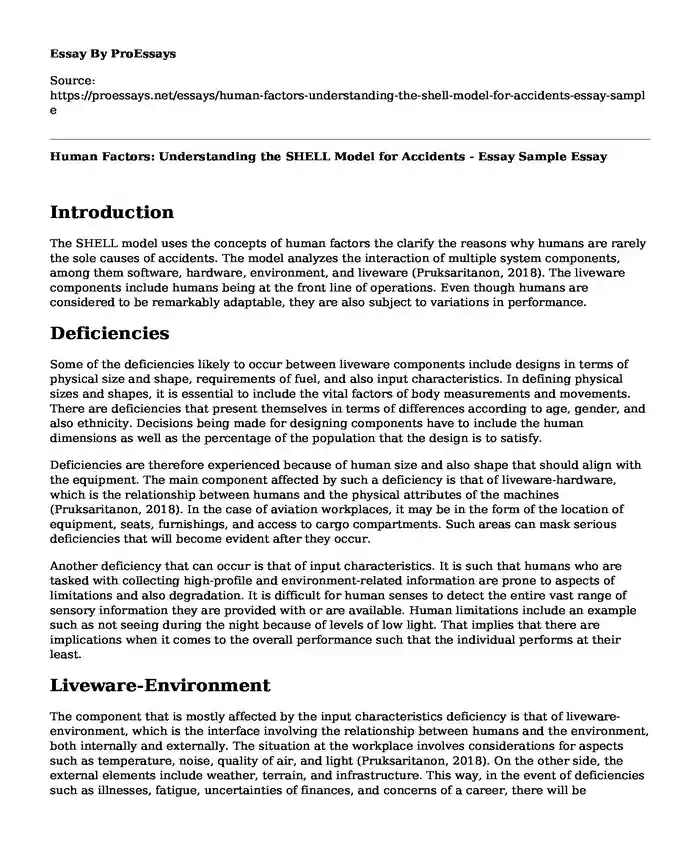Introduction
The SHELL model uses the concepts of human factors the clarify the reasons why humans are rarely the sole causes of accidents. The model analyzes the interaction of multiple system components, among them software, hardware, environment, and liveware (Pruksaritanon, 2018). The liveware components include humans being at the front line of operations. Even though humans are considered to be remarkably adaptable, they are also subject to variations in performance.
Deficiencies
Some of the deficiencies likely to occur between liveware components include designs in terms of physical size and shape, requirements of fuel, and also input characteristics. In defining physical sizes and shapes, it is essential to include the vital factors of body measurements and movements. There are deficiencies that present themselves in terms of differences according to age, gender, and also ethnicity. Decisions being made for designing components have to include the human dimensions as well as the percentage of the population that the design is to satisfy.
Deficiencies are therefore experienced because of human size and also shape that should align with the equipment. The main component affected by such a deficiency is that of liveware-hardware, which is the relationship between humans and the physical attributes of the machines (Pruksaritanon, 2018). In the case of aviation workplaces, it may be in the form of the location of equipment, seats, furnishings, and access to cargo compartments. Such areas can mask serious deficiencies that will become evident after they occur.
Another deficiency that can occur is that of input characteristics. It is such that humans who are tasked with collecting high-profile and environment-related information are prone to aspects of limitations and also degradation. It is difficult for human senses to detect the entire vast range of sensory information they are provided with or are available. Human limitations include an example such as not seeing during the night because of levels of low light. That implies that there are implications when it comes to the overall performance such that the individual performs at their least.
Liveware-Environment
The component that is mostly affected by the input characteristics deficiency is that of liveware-environment, which is the interface involving the relationship between humans and the environment, both internally and externally. The situation at the workplace involves considerations for aspects such as temperature, noise, quality of air, and light (Pruksaritanon, 2018). On the other side, the external elements include weather, terrain, and infrastructure. This way, in the event of deficiencies such as illnesses, fatigue, uncertainties of finances, and concerns of a career, there will be disturbances in the environment. In an example of an activity in aviation, the deficiency of human eye seeing during the night reduces the performance of the pilot during that time.
Conclusion
Another deficiency that can occur between liveware components is the need for fuel requirements. Humans need food, water, and also oxygen so that they can function effectively. This way, deficiencies in these aspects can influence their performance as well as general well-being. The component most affected by the deficiency is liveware-software that refers to the relation between humans and the surrounding systems. They will have issues with experience, the accuracy of tasks, general format and presentation as well as clarity. Humans generally have limitations that become deficiencies to their capabilities to work. Their effectiveness is altered by factors in their environment, and fixing it could help to make them function proficiently.
References
Pruksaritanon, S. (2018). Effects of Lighting and Noise on Performance and Situation Awareness in Air Traffic Control Tasks.
https://commons.erau.edu/cgi/viewcontent.cgi?article=1144&context=student-works.
Cite this page
Human Factors: Understanding the SHELL Model for Accidents - Essay Sample. (2023, Nov 01). Retrieved from https://proessays.net/essays/human-factors-understanding-the-shell-model-for-accidents-essay-sample
If you are the original author of this essay and no longer wish to have it published on the ProEssays website, please click below to request its removal:
- Free Will, Determinism, and Compatibilism Essay Example
- Screening and Early HIV Treatment Paper Example
- Essay Example on Informatics Programs to Curb Spread of Infectious Diseases
- Paper Example on Include Dietary Fats for Body Energy, Cell Growth, Body Warmth & Nutrient Absorption
- Essay Sample on Partnering with Alabama Public Health Districts: Health & Community Benefits
- Essay Example on Health Professionals: Navigating Dilemmas of Medical Errors
- Paper Example on Exercising Free Will: Understanding Choices & Consequences







